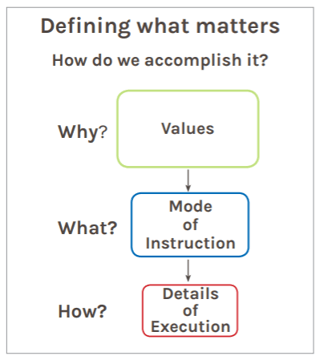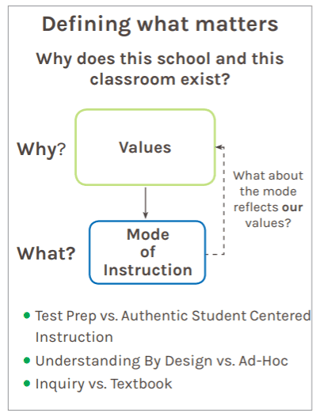 Some values will resonate with us, and some simply will not. Modes of instruction like test prep, for example, are not going to resonate with the values of schools and districts where authentic student-centered instruction is a value, because the drill-and-kill nature of test prep is simply at odds with authentic teaching. To participate in that is a violation of the values of the school and of the district.
Some values will resonate with us, and some simply will not. Modes of instruction like test prep, for example, are not going to resonate with the values of schools and districts where authentic student-centered instruction is a value, because the drill-and-kill nature of test prep is simply at odds with authentic teaching. To participate in that is a violation of the values of the school and of the district.
How we go about our work matters deeply for how successful we are in introducing effective STEM instruction into our schools. It also matters deeply for how successfully you manage to knit your team together and earn their respect as a leader.
In the example here, we can see that the what and the why of everyday instruction must align to our values, or we won’t get very far. Instead, mode of instruction (the what) must match our values (the why).
That’s why test prep just doesn’t get very far in districts that prize student-centered instruction. It’s also why schools that value inquiry don’t do well if forced to rely heavily on textbook learning, and why schools that care about well-designed curriculum don’t go in for ad hoc, single-purpose learning.
If we all share a value – such as understanding by design, authentic learning, or inquiry – and we are asked to use a mode of instruction that goes against that, it is a violation of our values both as individuals and as teams. If you’re a teacher, you’re engaging in it. If you’re a principal, you’re promoting it.
This highlights other important ideas as well. If you bring people into your group who don’t share your values, you’re going to have a problem. If you use a hiring process or coaching process that doesn’t carefully align to these values, you will not see them reflected in modes of instruction.
That’s why it’s so crucial to align your values throughout the school, not just in one unit, one classroom or on one team, but everywhere.
 Our “what,” our mode of instruction, always reflects someone’s values. That’s why it’s so crucial to focus on values when we’re working to institute new material. The values backing that material will inform our modes of instruction as well as the details of execution, or the “how” we teach. There is no separating the one from the other.
Our “what,” our mode of instruction, always reflects someone’s values. That’s why it’s so crucial to focus on values when we’re working to institute new material. The values backing that material will inform our modes of instruction as well as the details of execution, or the “how” we teach. There is no separating the one from the other.
In this image, it’s easy to see how the why trickles down to the what, which in turn informs the how. These are irrevocably tied. That means if our modes of instruction become fractured, then the means by which we actually accomplish our jobs in the classroom, the details of execution, also become highly fragmented.
Then you’ll see situations like this one: You observe a classroom filled with excellent modes of instruction, and it is totally in line with what you personally value. You promote these modes of instruction, believe strongly in them and are glad to see them coming to life in this classroom. Then you go next door and find something that's totally out of alignment. This is not an uncommon situation, and can happen to you as a teacher, a principal or an administrator.
How, you might be wondering, does this happen? It happens when schools and districts focus on the how. They focus on the details of execution, or sometimes on the modes of instruction, but they very rarely focus on the why—the values which unite us all as educators in that building and the real purpose for which we're all teaching.
When that happens, when our values aren’t aligned, we are bound to use different modes of instruction no matter what our school or district emphasizes, as well as different details of execution.
Determine Your Own Values, and Those of Your Group
That’s why we encourage you, as these changes occur or as you're preparing and thinking about these changes, to absolutely focus first on determining what you value individually and as a group. Afterwards, ask yourself follow-up questions:
- What do I value individually that I share with this group?
- Where do we come together?
- Where are the overlapping pieces?
- What modes of instruction already exist in my school?
- Do these modes of instruction reflect my values?
- Why or why not?
- What details of execution follow from these modes of instruction?
- What do I really consider to be acceptable instruction?
- How do I go about it?
Let’s consider this last question for a moment. If you believe that the only acceptable teaching is authentic inquiry, and the appropriate details of the execution are demonstration, textbook reading and students repeating information, then something is out of alignment. Authentic inquiry is not just reading. It's not a teacher acting as a sage and delivering content unilaterally.
The idea that learning from a textbook will actually engage future scientists and engineers is false, and you lose the opportunity to meaningfully and authentically instruct students in developing and using their skills in the context of the content. That’s why it’s so important to ask yourself and your team these questions, so you pinpoint where the misalignment and misunderstanding is occurring, and then fix them. That way, your values dictate modes of instruction and details of execution. However, as we will see, these can also inform your values.
 While modes of instruction and details of execution should never operate in a value-less vacuum, it is important to ensure that they’re on track with values.
While modes of instruction and details of execution should never operate in a value-less vacuum, it is important to ensure that they’re on track with values.
You should always be checking both against your values, asking questions like “does execution mirror our values?” and “does execution mirror our mode?” That way, you develop a feedback loop where all three remain in alignment.
The image here is an effective way to iron out the issues that come with misalignment. It’s important to not only ask yourself the above questions to get clear on your values and how they dictate your what and your how, but also to continue to ask whether all three are lining up over time.
As you engage students with new material and new forms of instruction, always be looking at the modes of instruction and the details of execution you use, asking:
- We say we're about this, but are we really doing it?
- Does it mirror the mode?
- Does it reflect the values?
- If it doesn't, how do we fix that?
And we need to realize that sometimes it isn’t an easy fix. We have to change totally.
We have to abandon the old ways and pick up something else, and go from there. This is true of the traditional model of instruction, which we talked about above. The truth is that it will largely need to be abandoned, or we will have real trouble instituting and living by the values that come with real, engaging and effective STEM instruction.
If people persist in valuing ideas that are contrary to the standards and purpose of performance-based expectations, which is what the Next Generation Science Standards represent, and if the resources and materials in professional development do not reflect that, then you've got an issue.
These changes aren't as simple as merely deciding to value the "right values". As leaders we need to identify and promote those common values and help out teams being having the conversations necessary to align their instructional pedagogy and content.


